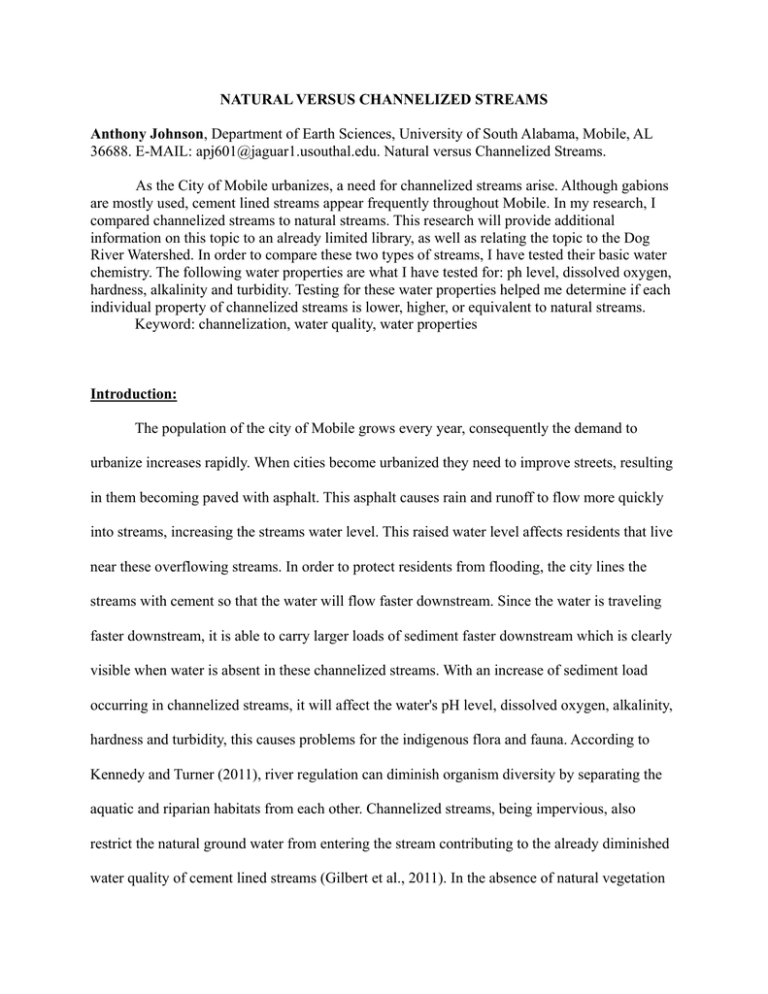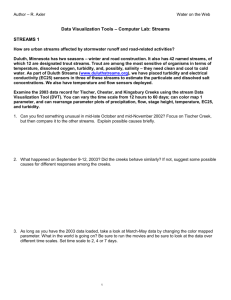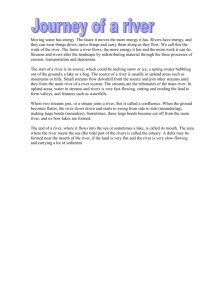NATURAL VERSUS CHANNELIZED STREAMS Anthony Johnson
advertisement

NATURAL VERSUS CHANNELIZED STREAMS Anthony Johnson, Department of Earth Sciences, University of South Alabama, Mobile, AL 36688. E-MAIL: apj601@jaguar1.usouthal.edu. Natural versus Channelized Streams. As the City of Mobile urbanizes, a need for channelized streams arise. Although gabions are mostly used, cement lined streams appear frequently throughout Mobile. In my research, I compared channelized streams to natural streams. This research will provide additional information on this topic to an already limited library, as well as relating the topic to the Dog River Watershed. In order to compare these two types of streams, I have tested their basic water chemistry. The following water properties are what I have tested for: ph level, dissolved oxygen, hardness, alkalinity and turbidity. Testing for these water properties helped me determine if each individual property of channelized streams is lower, higher, or equivalent to natural streams. Keyword: channelization, water quality, water properties Introduction: The population of the city of Mobile grows every year, consequently the demand to urbanize increases rapidly. When cities become urbanized they need to improve streets, resulting in them becoming paved with asphalt. This asphalt causes rain and runoff to flow more quickly into streams, increasing the streams water level. This raised water level affects residents that live near these overflowing streams. In order to protect residents from flooding, the city lines the streams with cement so that the water will flow faster downstream. Since the water is traveling faster downstream, it is able to carry larger loads of sediment faster downstream which is clearly visible when water is absent in these channelized streams. With an increase of sediment load occurring in channelized streams, it will affect the water's pH level, dissolved oxygen, alkalinity, hardness and turbidity, this causes problems for the indigenous flora and fauna. According to Kennedy and Turner (2011), river regulation can diminish organism diversity by separating the aquatic and riparian habitats from each other. Channelized streams, being impervious, also restrict the natural ground water from entering the stream contributing to the already diminished water quality of cement lined streams (Gilbert et al., 2011). In the absence of natural vegetation in the channelized streams, natural filtration of trash and run off is easily bypassed. Research Question: Do channelized and natural streams have a pronounced difference in water properties? This research has helped determine the answer to this question. It has also provided the Dog River community with a better understanding of how channelized streams are affecting the indigenous species in the area. With this understanding they are better to seek ways to improve the areas affected. Methods: To conclude whether natural streams are better than cemented streams, I had to implement various methods. I conducted the same methods for three natural and three channelized streams (Figure 1), each stream have been tested twice. Natural Study Site Channelized Study Site Fig. 1 Map of study sites Stream Road The following variables were tested for: air temperature, water temperature, pH, dissolved oxygen, alkalinity, hardness and turbidity. All of these variables determine if the stream can support life. Water and air temperature are some of the primary factors that influence the amount of dissolved oxygen contained in the water. Cary Institute states that warm water holds less dissolved oxygen than cold water (Ecostudies, 2009). Dissolved oxygen is an important variable; the EPA describes dissolved oxygen as the level of oxygen in its dissolved form in water. Also, when more oxygen is used than what is supplied the waters inhabitants may die or leave (EPA, 2001). Moving on to the pH level of water, it is a measure of how basic and acidic the water is. According to the University of Rhode Island, “Aquatic organisms need the pH of their water body to be within a certain range for optimal growth and survival. Although each organism has an ideal pH, most aquatic organisms prefer pH of 6.5 – 8.0. Outside of this range, organisms become physiologically stressed. Reproduction can be impacted by out-of-range pH, and organisms may even die if the pH gets too far from their optimal range (Addy, 2004).” If water is considered hard it means that it is high in mineral content, this is called hardness. For alkalinity, Hopkins says that it is the water's ability to neutralize the acid contained in the water (Hopkins, 2001). When measuring turbidity, you are determining how cloudy the water is. This research will provide the water quality information for each site, thus showing whether quality is better in either type of stream. Results: I tested three natural streams, each one twice. The natural streams I tested are the following: Moore Creek, Montlimar, and Eslava Creek. These creeks all had a vast amount of vegetation surrounding and with in them. Moore Creek in particular, there were small fish visible in it. The pH level ranged from 6.5 to 7.5. Hardness for natural streams was between 30 to 60 mg/L. Alkalinity had levels from 30 to 53 mg/L. Turbidity had values ranging from 0 to 10 JTU. As for dissolved oxygen, it varied from 62% to 110% saturation. I calculated the averages of the tested natural streams and displayed them in (Figure 2). 100 92.5 90 80 80 73.5 70 60 Moores 52.5 50 50 Montlimar 45 40 40 35 Eslava 32.5 30 20 10 6.5 7 6.5 5 7.5 0 0 pH Hardness Alkalinity Dissolved Oxygen Turbidity Fig. 2 Average water property values for Moore, Montlimar, and Eslava I also tested three channelized streams, each one twice. The tested channelized streams were Spencer Branch, Woodcock Branch, and Bolton Branch. Each creek had sediment on the bottom with either flowing or standstill shallow water. Spencer branch had some vegetation growing in it due to cracks in the lining. Bolton Branch had visible insects living within the water. For all the channelized streams, the pH level ranged from 7.5 to 10. Hardness for cement lined streams varied between 50 and 110 mg/L. Alkalinity had values ranging from 45 to 95 mg/L. Turbidity was absent except for one stream being 20 JTUs. Dissolved oxygen in the water ranged between 76% to 144% saturation. Just as the natural streams, I have calculated the average water quality properties for the channelized streams and displayed them in (Figure 3). 140 115 120 105 100 116.5 110 92.5 82.5 80 70 Spencer 70 Woodcock 60 Bolton 60 40 20 10 8.5 8.759.25 0 0 0 pH Hardness Alkalinity Dissolved Oxygen Turbidity Fig. 3 Average water property values for Spencer, Woodcock, and Bolton Discussion & Conclusion: When comparing the water property averages of natural and channelized streams, there are apparent differences. One such variable that differs is pH, natural streams had an average of 6.67 while the channelized streams had an average of 8.83. As stated before, organisms prefer to live in water that has a pH between 6.5 and 8.0. So it appears natural streams have better pH properties than channelized streams. One reason channelized streams have a higher pH is because of the high alkalinity levels, in which water alkalinity neutralizes acids. On the other hand, channelized streams contain higher levels of dissolved oxygen with an average of 113% compared to natural streams average of 82%. This may be due to the shallower waters that the channelized streams tended to have. Natural streams also have better quality in terms of hardness and alkalinity by having lower levels, hardness being 41 mg/L and alkalinity 43 mg/L. Channelized had a higher rate of 85 mg/L hardness and 74 mg/L alkalinity. The turbidity average did not differ much between the two types of streams, channelized streams had an average of 3.33 JTUs and natural streams had 4.16 JTUs. To see the differences visually, I have calculated the property averages of each type of stream and displayed them in a bar graph (Figure 4). 120 113 100 85 82 74 80 Natural 60 Channelized 41 43 40 20 6.67 8.83 4.16 3.33 0 pH Hardness (mg/L) Alkalinity (mg/L) Dissolved Oxygen Turbidity (JTU) (%) Fig. 4 Average water property values for natural and channelized streams Viewing the graph (Figure 4) shows that there is a pronounced difference between channelized and natural streams' water properties. To answer which stream type is better, the natural streams tended to have better water quality than channelized streams when taking all of the variables into consideration. These, in turn, mean that natural streams are better to keep for the health of the Dog River Watershed. Using these same methods for testing water quality there can be many projects for the DRW, practically anything along the lines of correlating other variables that may affect the water's natural state. References: "5.2 Dissolved Oxygen and Biochemical Oxygen Demand." Environmental Protection Agency. N.p, 2009. Web. 28 Feb. 2011. <water.epa.gov/type/rsl/monitoring/ vms52.cfm>. Addy, Kelly. "pH and Alkalinity." Kingston: University of Rhode Island, 2004. Print. "Disolved Oxygen." Ecostudies. N.p, 2009. Print. Gilbert, L., K. Phemister., and K. Prestegaard. “Effects of Concrete Channels on Stream Biogeochemistry, Maryland Coastal Plain.” American Geophysical Union. N.p, 2005. Web. 2 Apr. 2011. <adsabs.harvard.edu/abs/2005AGUSMNB21F..02P> Gregorio, Michael. “Geomorphic Effects of the Hocking River Channelization at Athens, Ohio, on the Downstream Planform.” Athens: Ohio University, 2008. Print. Hopkins, Steve. “Alkalinity- Where Does it Come From and Where Does it Go?." RainGarden. N.p, 2001. Print. Kennedy,Thomas, and Thomas F. Turner. “River Channelization Reduces Nutrient Flow and Macroinvertebrate Diversity at the Aquatic Terrestrial Transition Zone.” Ecosphere 2 (2011): 1-13. Print “Social and Economic Implications of Channelizing Streams.” Environmental Protection Agency Region 7, section 404. 2005. Print.




